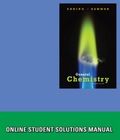
(a)
Interpretation:
The chemical equation for the given reaction has to be written
Concept Introduction:
Balanced Chemical equation:
A balanced chemical equation is an equation which contains same elements in same number on both the sides (reactant and product side) of the chemical equation thereby obeying the law of conservation of mass.
To Write: The chemical equation for the given reaction
(a)
Answer to Problem 21.148QP
The chemical equation for the given reaction is:
Explanation of Solution
Given data:
Burning of calcium metal in oxygen.
Chemical Equation:
The chemical equation for the reaction of burning of calcium metal in oxygen can be written as follows,
The chemical equation for the given reaction is written as:
(b)
Interpretation:
The chemical equation for the given reaction has to be written
Concept Introduction:
Balanced Chemical equation:
A balanced chemical equation is an equation which contains same elements in same number on both the sides (reactant and product side) of the chemical equation thereby obeying the law of conservation of mass.
To Write: The chemical equation for the given reaction
(b)
Answer to Problem 21.148QP
The chemical equation for the given reaction is:
Explanation of Solution
Given data:
Phosphine,
Chemical Equation:
The chemical equation for the reaction of burning of phosphine in excess of oxygen can be written as follows,
The chemical equation for the given reaction is written as:
(c)
Interpretation:
The chemical equation for the given reaction has to be written
Concept Introduction:
Balanced Chemical equation:
A balanced chemical equation is an equation which contains same elements in same number on both the sides (reactant and product side) of the chemical equation thereby obeying the law of conservation of mass.
To Write: The chemical equation for the given reaction
(c)
Answer to Problem 21.148QP
The chemical equation for the given reaction is:
Explanation of Solution
Given data:
Ethanolamine,
The
Chemical Equation:
The chemical equation for the reaction of burning of ethanolamine in excess oxygen by giving out nitrogen gas as one of the product can be written as follows,
The chemical equation for the given reaction is written as:
Want to see more full solutions like this?
Chapter 21 Solutions
Student Solutions Manual for Ebbing/Gammon's General Chemistry
- Complete and balance the equations of the following reactions, each of which could be used to remove hydrogen sulfide from natural gas: (a) Ca(OH)2(s)+H2S(g) (b) Na2CO3(aq)+H2S(g)arrow_forwardWrite balanced equations for the reaction of scandium metal to produce the scandium(III) salt with the following nonmetals: (a) sulfur (c) nitrogen (b) chlorine (d) oxygen (forming the oxide)arrow_forwardPhosphorus occurs naturally in the form of fluorapatite, CaF2 3Ca3(PO4)2. The dot indicates 1 part CaF2 to 3 parts Ca3(PO4)2. This mineral is reacted with an aqueous solution of H2SO4 in the preparation of a fertilizer. The products are phosphoric acid, hydrogen fluoride, and gypsum, CaSO4 2H2O. Write the balanced equation describing this process.arrow_forward
- Explain why sulfuric acid, H2SO4, which is a covalent molecule, dissolves in water and produces a solution that contains ions.arrow_forwardWrite balanced chemical equations for the following reactions: (a) metallic aluminum burned in air (b) elemental aluminum heated in an atmosphere of Chlorine (c) aluminum heated in hydrogen bromide gas (d) aluminum hydroxide added to a solution of nitric acidarrow_forward
 Chemistry by OpenStax (2015-05-04)ChemistryISBN:9781938168390Author:Klaus Theopold, Richard H Langley, Paul Flowers, William R. Robinson, Mark BlaserPublisher:OpenStax
Chemistry by OpenStax (2015-05-04)ChemistryISBN:9781938168390Author:Klaus Theopold, Richard H Langley, Paul Flowers, William R. Robinson, Mark BlaserPublisher:OpenStax Chemistry: Principles and ReactionsChemistryISBN:9781305079373Author:William L. Masterton, Cecile N. HurleyPublisher:Cengage Learning
Chemistry: Principles and ReactionsChemistryISBN:9781305079373Author:William L. Masterton, Cecile N. HurleyPublisher:Cengage Learning Chemistry & Chemical ReactivityChemistryISBN:9781337399074Author:John C. Kotz, Paul M. Treichel, John Townsend, David TreichelPublisher:Cengage Learning
Chemistry & Chemical ReactivityChemistryISBN:9781337399074Author:John C. Kotz, Paul M. Treichel, John Townsend, David TreichelPublisher:Cengage Learning Chemistry & Chemical ReactivityChemistryISBN:9781133949640Author:John C. Kotz, Paul M. Treichel, John Townsend, David TreichelPublisher:Cengage LearningChemistry: Matter and ChangeChemistryISBN:9780078746376Author:Dinah Zike, Laurel Dingrando, Nicholas Hainen, Cheryl WistromPublisher:Glencoe/McGraw-Hill School Pub Co
Chemistry & Chemical ReactivityChemistryISBN:9781133949640Author:John C. Kotz, Paul M. Treichel, John Townsend, David TreichelPublisher:Cengage LearningChemistry: Matter and ChangeChemistryISBN:9780078746376Author:Dinah Zike, Laurel Dingrando, Nicholas Hainen, Cheryl WistromPublisher:Glencoe/McGraw-Hill School Pub Co Chemistry: The Molecular ScienceChemistryISBN:9781285199047Author:John W. Moore, Conrad L. StanitskiPublisher:Cengage Learning
Chemistry: The Molecular ScienceChemistryISBN:9781285199047Author:John W. Moore, Conrad L. StanitskiPublisher:Cengage Learning





